By Annie Myers
After preheating the oven, student nutrition assistant Michelle Kile spreads chicken patties onto a pan on Friday, Oct. 28.
Food for Thought: District offers a multitude of healthy food options for students
USD 232 encourages students to make healthy food choices in their implementation of national programs
November 21, 2016
As a freshman walks into his or her first time through the lunch line, the sheer amount of choices available often leave them taken aback. Alongside hamburgers and pizza, there are vegetarian and, on request, gluten-free options, yet everything follows the strict nutrition guidelines set by the federal government.
The implementation of the Healthy Hunger-Free Kids Act of 2010 adds to the long list of requirements schools follow in order to receive federal funding for lunch and breakfast. These guidelines limit amounts of sugar, fat and calories, while encouraging hearty servings of the main food groups. In the same year, USD 232 made changes to its lunch policy.
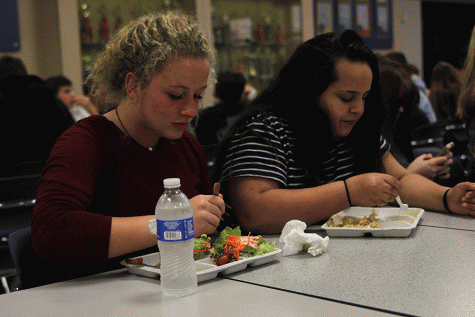
Sophomores Grace Goetsch and Claire Segura eat lunch together on Thursday, Nov. 3.
The district has changed its nutritional policies before, so, according to Health teacher Amy McClure the adjustment to the 2010 plan has not been as extreme compared to other districts around the country.
“There have been some schools that haven’t been open to the idea [of changing the lunch program],” McClure said. “It’s because they waited until the last minute to incorporate it into their program. This process [of changing the nutritional policies] started eight years ago, and if you took the steps to plan ahead and make that a part of your school lunch program, then it was an easy change.”
In order for changes in the lunch program to be enacted, the director of student nutrition is in charge of deciding what food is in, or out, of the district’s menu. Calories are counted, serving amounts are tracked, and all of it has to meet federal guidelines in order to be served at school.
This year’s director of student nutrition is Jolyn Mortenson, who graduated with a Bachelor of Science in Dietetics and Nutrition from Iowa State University and a Master of Science in Dietetics and Nutrition from the University of Kansas Medical Center. Mortenson has now taken over the duties of overseeing the entire district’s menus and nutrition plans.
“My job is to find products that fit the standards and are also appealing in taste and looks to students — we eat with our eyes,” Mortenson said via email. “I try to use input from students, kitchen staff, USD 232 employees and parents to listen … we are continually on the search for new and exciting items that students love, as well as meeting federal guidelines.”
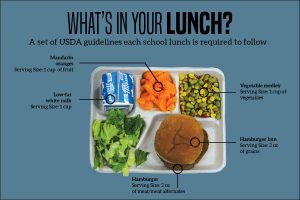
All of this planning does more than just look good on paper. Healthy eating has both immediate and long term results, something that students in required sophomore Health classes learn about alongside how to eat healthy in the first place.
“[In Health], we talk about the basic nutrients that are important that you take in in your diet,” McClure said. “We talk about healthy eating patterns, meaning teenagers should enjoy their favorites only in moderation; eat food from all the food groups, try to get a diet that is lower in fats, sodium and sugar, and has more of those nutrients that we talk about.”
Students who know how to make healthy decisions are more likely to make them, and can see immediate change in mood as well as a long term boost in health, according to Mortenson.
“They are more focused, feel energetic, are at a lower risk for developing chronic diseases, and have greater longevity of life,” Mortenson said. “Compared to those who eat an unhealthy diet, they may feel more lethargic, have a harder time focusing and have a greater chance of developing chronic diseases.”
According to McClure, others effects include weight gain, high cholesterol, high blood pressure, heart disease, diabetes, “to name a few.”
The decisions students make about their diets affects both their physical and their mental well-being, according to senior football player Jake Campbell. Campbell notices a distinct difference between his diet during football season and the off-season, with more protein and less carbs.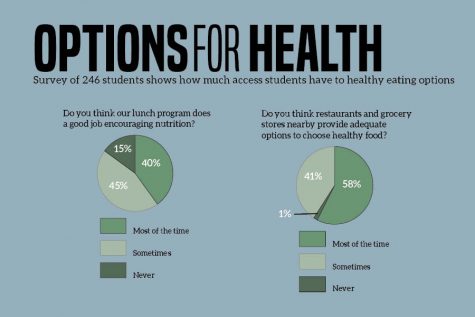
“More protein helps [on the football field] than anything.” Campbell said. “Carbs help, but when I eat a lot of carbs, I kind of get more indigestion. So I always try to limit how much bread I take in [during football season] and eat more protein.”
While some students struggle with being unhealthy, others integrate nutrition like second nature. Junior Dani Crispin has been a vegetarian her entire life, and that nutrition-focused lifestyle encourages her to eat healthier than the average teenager. Crispin said her mother likes to “give [her] good habits that’ll continue when [she] gets older.”
For those who may not eat nutritious food as diligently as Crispin, healthy options are available at school for a low cost, and according to McClure, change depends on the decision to begin. McClure believes that although it may be easy to start, sticking with a balanced diet takes dedication.
“Teenagers and adults both have the attitude that they need instant gratification,” McClure said.“Whether it’s information they want to find on a computer, or if it’s an answer to a question, or if it’s just food in general. People have to realize that healthy food takes time, takes planning, takes effort, but you’re investing in the health of your body, so it should be worth that extra money and extra time and effort to find those healthy options.”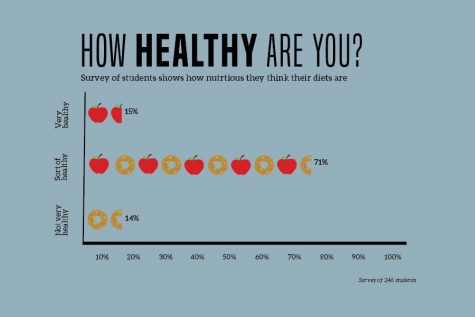
In the long run, Crispin believes her healthy eating habits will help her. In addition to feeling better about herself, she “probably won’t have that many health problems related to bad eating.”
“When I eat good and healthy, I feel so much better,” Crispin said. “Especially on tests, I get queasy if I don’t have food that’s like fruit or protein because I just won’t feel good. It helps a lot when I feel healthier.”
Although expensive, healthy options are available widespread from the school lunch line all the way to the nearby Price Chopper. Due to this easy access, McClure believes making nutritious decisions is something all Americans could improve on.
“Healthy food is there,” McClure said. “You just have to be willing to spend the money on it, and be willing to incorporate that into your daily routine. It is not always the cheapest or easiest option, but it is definitely the best.”
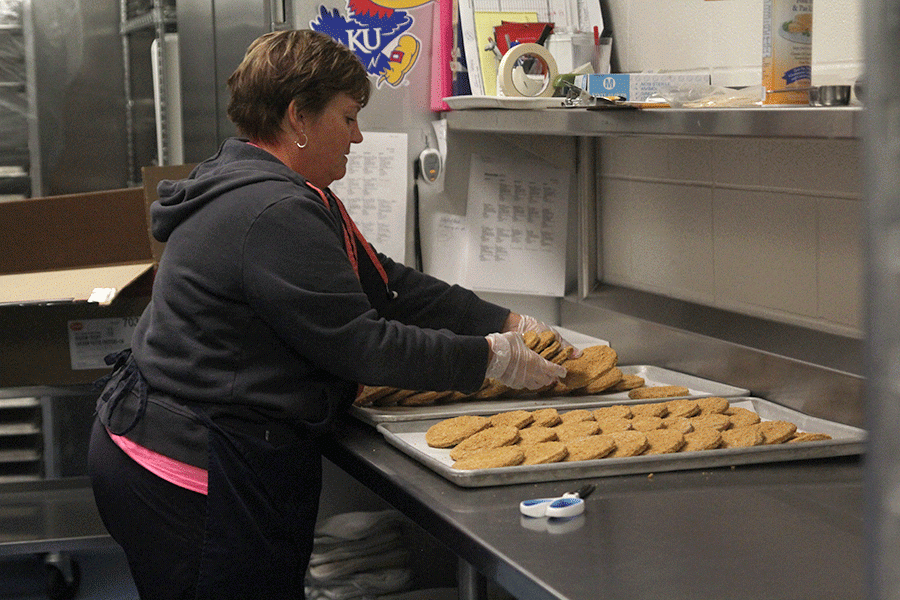
Sid Jambunathan • Nov 25, 2016 at 9:59 pm
I won’t recognize the Mill Valley cafeteria as legitimate until they start serving kale and quinoa.